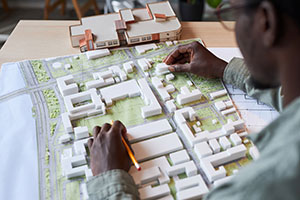December 12, 2023 / by Michael Evans
Embarking on a development project is an exhilarating journey filled with excitement, challenges, and endless possibilities. However, amidst the thrill of envisioning your project come to life, lies the daunting task of navigating the labyrinth of zoning regulations and permitting processes. In this comprehensive guide, we’ll delve deep into the intricacies of zoning laws and permitting procedures, equipping you with the knowledge and strategies needed to navigate this crucial aspect of the development process with confidence and success.

Understanding zoning regulations
Zoning regulations serve as the backbone of urban planning, dividing land into different zones based on designated land uses and development standards. Whether you’re eyeing a plot of land in the heart of a bustling metropolis or nestled in the serene countryside, familiarizing yourself with the local zoning ordinance is paramount. Here are some key factors to consider:
1. Zoning districts
Each municipality delineates zoning districts, such as residential, commercial, industrial, and mixed-use, each with its own set of regulations governing permissible land uses, building heights, setbacks, and lot coverage. Understanding the zoning district of your prospective site is the first step towards aligning your development plans with regulatory requirements.
2. Special use permits and variances
In some instances, your proposed development may not conform to the strict parameters outlined by the zoning ordinance. In such cases, you may need to apply for special use permits or variances to deviate from the standard regulations. These applications typically require a thorough justification and may involve public hearings and review by zoning boards or planning commissions.
3. Overlay districts and design guidelines
Overlay districts impose additional regulations on top of the base zoning regulations to address specific concerns, such as historic preservation, environmental conservation, or transit-oriented development. Additionally, many municipalities have design guidelines aimed at ensuring new developments contribute to the overall character and aesthetic quality of the community.
Navigating the permitting process
Securing the necessary permits is a critical step in the development process, ensuring compliance with building codes, safety standards, and environmental regulations. While the permitting process may vary in complexity and duration depending on the jurisdiction, there are common steps and considerations that apply across the board:
1. Preliminary consultation
Before diving into the permit application process, it’s advisable to schedule a preliminary consultation with the local permitting authority or planning department. This allows you to discuss your project in detail, identify potential challenges or requirements, and gain valuable insights into the regulatory landscape.
2. Comprehensive plan review
The heart of the permitting process involves submitting a comprehensive set of plans and documents for review by the relevant regulatory agencies. This typically includes architectural drawings, site plans, engineering calculations, environmental assessments, and any other pertinent information. The thoroughness and accuracy of your submission can significantly impact the speed and efficiency of the review process.
3. Permit application and review
Once your plans are in order, it’s time to submit your permit application along with the requisite fees. Depending on the scope of your project, you may need to apply for multiple permits, such as building permits, electrical permits, plumbing permits, and mechanical permits. Each permit application undergoes rigorous scrutiny to ensure compliance with applicable codes and regulations.
4. Inspections and compliance
Upon approval of your permit application, the real work begins. Throughout the construction process, you’ll be subject to periodic inspections by building inspectors to verify compliance with approved plans and code requirements. It’s essential to maintain open lines of communication with inspectors, address any issues promptly, and keep detailed records of construction activities and inspections.
International considerations
While the principles of zoning regulations and permitting processes are universal, the devil is in the details when it comes to international differences. Cultural norms, legal frameworks, and administrative procedures vary widely from country to country, posing unique challenges for developers operating in foreign markets. Here are some key considerations for navigating international development projects:
1. Legal and regulatory frameworks
Before venturing into a new market, conduct thorough research to understand the legal and regulatory framework governing development activities in the target country. This includes zoning laws, building codes, environmental regulations, and permitting procedures. Engage local legal counsel or consultants with expertise in the local market to guide you through the intricacies of the regulatory landscape.
2. Cultural and social dynamics
Cultural nuances and social dynamics play a significant role in shaping development patterns and regulatory practices. What may be acceptable or commonplace in one country may be taboo or heavily regulated in another. Take the time to familiarize yourself with the cultural context and sensitivities of the local community to avoid unintended conflicts or misunderstandings.
3. Political and economic considerations
Political stability, economic conditions, and government policies can exert a profound influence on the development process. Be mindful of geopolitical risks, macroeconomic trends, and regulatory changes that may impact your project’s feasibility and timeline. Establishing strong relationships with local stakeholders, government officials, and community leaders can help navigate political and economic uncertainties effectively.
4. Language and communication
Effective communication is essential when navigating international development projects, particularly in multilingual environments. Ensure that all contracts, agreements, and documentation are translated accurately and that you have access to proficient translators or interpreters as needed. Building trust and rapport with local partners and stakeholders through clear and transparent communication is key to project success.
Navigating zoning regulations and permitting processes is undoubtedly a daunting task for developers, but armed with the right knowledge and strategies, it becomes a manageable endeavor. By understanding the intricacies of zoning laws, engaging proactively with regulatory authorities, and adapting to international differences, developers can overcome challenges and unlock the full potential of their projects. So, roll up your sleeves, dive into the regulatory maze, and let your vision come to life one permit at a time. Happy developing!
